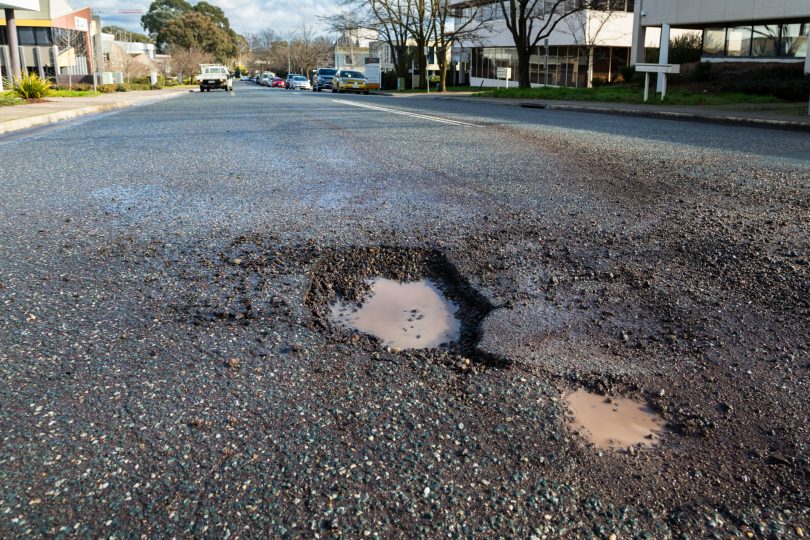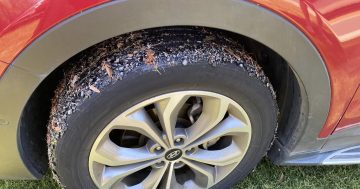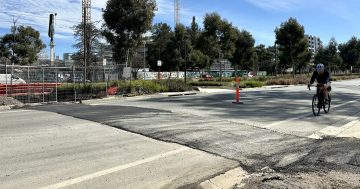
This pothole has been around so long it is birthing another. Photo: Michelle Kroll.
Canberra’s wet winter continues to wreak havoc on the ACT’s roads, with crews scrambling to keep up with the number of potholes and sections of frayed bitumen.
There was a time a pothole was a rare sight in the national capital, but increased traffic volumes and more heavy vehicles are taking a greater toll on our roads. Add water, which enters through small cracks in the road surface and undermines it, and the result is a nightmare for motorists trying to preserve their vehicles’ tyres and wheels.
In the last financial year, pothole repairs tripled from 2,719 in a much drier 2019-20 to 6,375.
In June alone, more than 500 potholes were fixed.
The February Budget recognised the damage the wetter conditions were inflicting, releasing an extra $6 million so additional crews could respond to community requests for pothole repairs and grass mowing.
Potholes were in the top five issues reported to the ACT Government’s Fix My Street portal in 2020-21, sitting at number three with a total of 3,297 requests, including nearly 300 for June. Street lights (the majority relating to bulb replacement) and illegal parking were the main issues raised.
Tyre and mechanical repair shops say they are being run off their feet this year keeping up with the number of punctures, damaged and shredded tyres, and cracked wheel rims.
Jax Fyshwick’s Daniel Bowen said the run started at the beginning of the year. He questioned the government’s priorities.
“They’re too interested in the tram instead of fixing the roads,” he said.
Mr Bowen said vehicles with skinny tyres such as Mercedes and BMWs were the most vulnerable as they could not absorb the shock of hitting a pothole as much as standard tyres.
Some customers had made claims through Access Canberra, but he did not know the outcomes.
Les Skurowski from Beaurepaires Braddon said some roads were like a patchwork quilt from all the pothole repairs.
One customer had told him: “I just zig-zagged around the road because of all the potholes.”
He was seeing damaged or destroyed tyres mostly.
Mr Skurowski said many of the main roads had cracks and the rain was doing the rest.
He remembers how the government used to seal cracks with bitumen lines but said that just made the roads slippery.
Troy Bolton from Goodyear Fyshwick said he was seeing a lot of bent and cracked rims and damaged sidewalls of tyres.
A recent customer had a tyre with a bulge the size of a baby’s head, which could have easily exploded.
“It’s pretty bad. We’re getting a lot,” Mr Bolton said.
“They’re just driving along, and all of a sudden, bang, there’s a pothole.”
Short of every pothole being filled, all three said drivers just had to take more care, slow down and stop tailgating so they could see the road more clearly.
The government says it has a proactive program to inspect key arterial roads and responds to community requests of dangerous potholes, which it triages.
But it is obviously struggling to keep up as many potholes have lain untouched for months and are growing in size while sections of roads, particularly at some major intersections, are crumbling and will require resealing.
A government spokesperson said the next round of the road resealing program about to get underway will help the situation.
But with the Bureau of Meteorology predicting above-average rainfall to October, it will be a constant battle to hold Canberra’s roads together.
The spokesman could not say if extra money will be allocated in the Budget to be handed down on 31 August.














